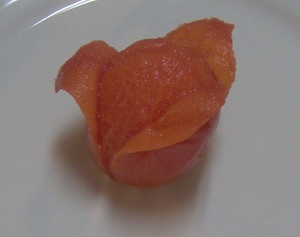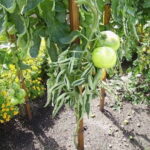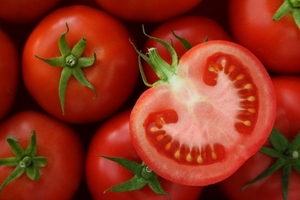What is Blanching?
Blanching is a method of ingredient preparation that shocks the fresh food, usually a fruit or vegetable, by first submerging it in boiling water, then moving it directly to ice water.
Blanching is used for many things in cooking. It brightens and locks in color for foods like fresh green beans, sterilizes the skin of foods that will be served skin-on, and helps to easily remove the skins of those foods you want to peel.
In this case we will be blanching tomatoes for the purpose of skinning them, or peeling their skins. Many cooked tomato recipes call for the use of skinned tomatoes. Anyone who has tried to skin tomatoes raw knows that this can be an exercise in frustration. The trick is to blanch your tomatoes immediately before you skin them.
Preparing To Blanch & Skin Tomatoes
To blanch and skin your tomatoes you will need certain things. It’s best to get everything set up before you begin. Once you begin the process it go faster than you think, and it’s very easy to over-cook tomatoes while blanching.
Blanching pot – First you will need a pot big enough to hold all of your tomatoes. Fill the pot halfway with water and bring to a boil. If you’re working with more than two dozen tomatoes at a time (24+), you will want to divide them up into batches that are smaller than 24 to make them easier to work with.
Blanching bowl – You will need a bowl that is slightly larger than your pot. There would be enough room in the bowl for a batch of tomatoes to float freely when it’s half filled with ice water.
Prep and discard bowls – You will want two more bowls to work with, one for putting the blanched and peeled tomatoes in, and one for the skins and other discarded pieces.
Paring knife – The paring knife is used to hatch the skins and then remove with stem bases if you desire.
Step 1 – Wash and Hatch Tomatoes
Before you blanch tomatoes wash them and mark their skins with a small X using your paring knife. The X, or hatch mark, should be only shallow enough to cut the skin of the tomato and allow water to seep up under it. By hatch marking the skin you give the water baths, both boiling and ice, a place to start working.
Step 2 – Briefly Boil Tomatoes
Submerge your tomatoes into boiling water. Most tomatoes will sink to the bottom of the pot, but some may float. This is nothing to worry about. Some tomatoes simply retain more air than others, but it doesn’t effect the blanching technique.
How long you leave your tomatoes in the boiling water to blanch will depend on two things: the size of the tomato and the ripeness. It’s best to use tomatoes that have just become fully ripe, but have not begun tot soften. Overly ripe tomatoes will burst and bleed away the riper portions.
Tiny tomatoes, like grape and cherry tomatoes, will cook fast, so you don’t want to leave them in the boil pot for more than 30 seconds. Small tomatoes, like romas and campari will take about a full minute. Larger tomatoes, like steakhouse, will take 2-3 minutes.
You will know it’s time to remove your tomatoes from the boiling water when the skins begin to shrink back.
Step 3 – Cool Tomatoes in Ice Bath
To finish the blanch, transfer your tomatoes directly from the boiling pot to the ice water bowl. Simply drop them in. Let them sit for 2-3 minutes in the ice bath, or until they’re cool when handled. Don’t let them sit for too long, however, as they will begin to break down in the water.
Step 4 – Skin Tomatoes
When the blanched tomatoes are cool you can begin skinning them. This is very easy to do. Using clean hands, pick one up and slide the skin off. It should just push right off with very little pressure. If it does not it may need to be returned to the boiling pot for another 30 seconds, then bathed again in the ice water.
At this point you may also choose to use your paring knife to remove the stem bases from the tomatoes. This is optional, however, as the stem base is now cooked, and completely eatable. Whole peeled tomatoes that have been industrially canned usually have their stem bases left in tact. This is because A) it’s easier, and B) the stem bases help the tomato retain its shape after it’s skin has been removed.
Done – Skin Tomatoes Storage and Use
Your tomatoes are now ready to be used in your recipe. Tomatoes don’t last very long after they’ve been skinned. They will keep for a day or two in an air-tight container in the refrigerator, or can be pressure canned for use at a later date. Do not freeze skinned tomatoes unless you don’t mind if they loose their shape.
Happy Eating!







